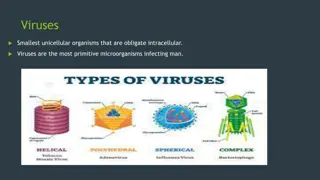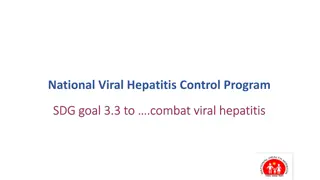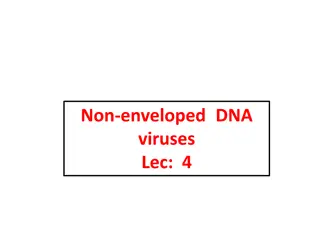Epidemiology of hepatitis C in Ireland
Hepatitis C, a viral infection affecting the liver, has notable implications in Ireland, with key transmission routes, clinical manifestations, and long-term consequences shaping its epidemiology. From transmission patterns to chronic infection risks, understanding the natural history and prevalence
0 views • 24 slides
Understanding Viruses, Viroids, and Prions: A Comprehensive Overview
Explore the fascinating world of viruses, viroids, and prions, from their discovery to their genetic material and hosts. Learn about the structure, genome, and sizes of viruses, as well as their interactions with different host cells. Gain insights into these acellular disease-causing agents and the
0 views • 17 slides
The Origin of Viruses: Theories and Evidence
Viruses are acellular parasites with a complex replication mechanism. Studies on their origin present challenges due to the lack of fossils. Three main hypotheses include regressive, cellular origin, and co-evolution. The regressive hypothesis suggests viruses originated from complex ancestors that
2 views • 25 slides
Understanding the Structure and Symmetry of Viruses along with Cultivation Methods
Viruses, defined as obligate intracellular parasitic organisms, exhibit general properties such as small size, filterability, simple structure, and absence of cellular components. They vary widely in size and lack independent metabolism. The cultivation of viruses plays a crucial role in studying th
3 views • 37 slides
Understanding Enveloped and Non-enveloped DNA Viruses
Non-enveloped DNA viruses, surrounded by a protein capsid, are resistant to sterilization and thrive in acidic environments. Adenoviruses, a common non-enveloped type, spread through close contact and contaminated objects. Additionally, Papilloma and Polyoma viruses, causing persistent infections an
0 views • 23 slides
Ethiopia's Initial Experience on Hepatitis B Birth Dose Pilot Implementation
Ethiopia's initial experience on Hepatitis B birth dose (HepB-BD) pilot implementation includes background statistics, HBsAg prevalence, hepatitis B vaccination coverage, distribution of HBV infection, existing guidelines/strategies, and activities prior to the start of HepB-BD piloting.
0 views • 17 slides
Clinical Excellence in Hepatitis C Nursing: SCENS Program Overview
Demonstrating competency in infection control, abdominal assessment, specimen collection, and communication is crucial in nursing care for patients with Hepatitis C. The SCENS program focuses on key learning objectives to enhance clinical proficiency, address potential issues, and understand the com
0 views • 12 slides
Understanding OSHA Bloodborne Pathogens Training and Hepatitis B Virus
Covering the basics of OSHA Bloodborne Pathogens Standard, this training material provides essential information on bloodborne pathogens, including Hepatitis B Virus (HBV). It emphasizes the importance of training for individuals with occupational exposure, outlining crucial topics such as Hepatitis
2 views • 56 slides
Canine Infectious Hepatitis (ICH) - Overview, Symptoms, and Treatment
Canine Infectious Hepatitis (ICH), also known as Rubarth's Disease, is caused by Canine Adenovirus-1 (CAdV-1), affecting dogs of all ages. The virus primarily targets hepatocytes, leading to acute hepatitis, as well as respiratory and ocular issues. Transmission occurs through contact with infected
6 views • 7 slides
Hepatitis B BD Introduction Plan in Ghana
In Ghana, the introduction plan for Hepatitis B BD involves evaluating disease burden, estimating seroprevalence among pregnant women, obtaining necessary approvals, presenting evidence to NITAG, and seeking support for introduction. A policy for screening and prevention is in place, aiming to addre
1 views • 10 slides
Introduction of Hepatitis B Birth Dose in Mozambique: A Step Towards Comprehensive Prevention
Mozambique is gearing up to introduce the Hepatitis B birth dose as a strategic approach in its immunization program, aiming to tackle the high prevalence of HBV within the population, particularly among women and HIV-positive individuals. The country's existing policies on screening pregnant women
0 views • 15 slides
Understanding the Transmission of Viruses: Routes and Implications
Viruses are intracellular parasites that require transmission to a new host to evade immune responses. This transmission process, whether through respiratory droplets, fecal-oral routes, or sexual contact, is crucial in the viral life cycle. Different modes of transmission, such as horizontal and ve
0 views • 11 slides
Understanding Viruses: Basics and Morphology
Viruses are the smallest unicellular organisms that are obligate intracellular. They lack cellular organization like bacteria, and their multiplication is complex. Viruses have either DNA or RNA and are classified based on their nucleic acid. Their structure includes nucleic acid and a capsid compos
0 views • 29 slides
National Viral Hepatitis Control Program - Achieving Universal Health Coverage and Elimination Goals
The National Viral Hepatitis Control Program in India is working towards combating viral hepatitis and achieving SDG goal 3.3 through a comprehensive approach that includes awareness generation, prevention, management, and financing under the NHM. The aim is to eliminate hepatitis C by 2030, reduce
0 views • 19 slides
Understanding Computer Viruses: Types, Prevention, and Top 5 Destructive Viruses
Computer viruses are malicious software programs that can cause significant harm. Learn about different types of viruses, symptoms of infection, stages of a virus, prevention measures, and the top 5 most destructive viruses of all time.
0 views • 11 slides
Understanding Computer Viruses: Threats and Categories
Learn about computer viruses, their history, classification, and impact. Explore different types like file viruses, polymorphic viruses, and stealth viruses. Understand the categories based on impact and discover macroviruses related to office applications.
1 views • 47 slides
Understanding How Viruses, Bacteria, and Fungi Impact Human Health
Explore the intricate world of viruses, bacteria, and fungi and how they interact with living organisms. Learn about the structure and functions of viruses, the role of bacteria in diseases, and the implications of fungi on human health. Discover the different ways these microorganisms affect us and
0 views • 37 slides
Understanding Viruses: Origin, Structure, and Importance in Research
Viruses are microscopic organisms that rely on living cells to replicate and cause a range of illnesses in humans, animals, and plants. Studying viruses has led to significant scientific breakthroughs, providing insights into essential biological mechanisms and disease processes. Theories on the ori
0 views • 20 slides
Understanding Viruses and Bacteria: A Biology Presentation by Mandie Lynn Walls
Explore the world of viruses and bacteria through this engaging biology presentation put together by Mandie Lynn Walls. Learn about the structure of viruses, different types of viruses like T4 Bacteriophage and Herpes Virus, the distinction between viruses and bacteria such as E. coli, vaccination m
0 views • 39 slides
Elimination of Hepatitis C in Individuals With HIV Infection
Discussing the goals, treatment options, and global impact of Hepatitis C in individuals with HIV infection, this presentation by Dr. David L. Thomas from Johns Hopkins Medical Institutions sheds light on important aspects such as mortality projections, WHO elimination goals, and targets for hepatit
0 views • 40 slides
Decline of Hepatitis C in England: 2022 Report Highlights
The 2022 report on Hepatitis C in England shows a continued decline in the prevalence of chronic HCV infection, with around 81,000 individuals estimated to be affected in 2020. The report also highlights the distribution of infections among individuals with different drug injecting histories. Data f
0 views • 41 slides
Hepatitis C Screening Recommendations for Adults (2017)
The Canadian Task Force on Preventive Health Care (CTFPHC) released recommendations on Hepatitis C screening for adults in 2017. The guidelines provide an overview of screening methods, key findings, implementation considerations, and conclusions. Those at higher risk for HCV in Canada include indiv
0 views • 38 slides
Novel RNA Viruses in Oysters Revealed by Virome Study
Oysters, as high-yield mariculture varieties, were investigated for novel RNA viruses using virome analysis. Eighteen new RNA viruses were identified, with evidence of genetic recombination. This study highlights the importance of advanced sequencing technologies in discovering viral pathogens in aq
0 views • 11 slides
Understanding Zoonotic Hepatitis A Virus Infections
Zoonotic hepatitis A virus infections primarily affect humans and nonhuman primates, with transmission occurring through fecal-oral route. This article delves into the reservoir, mode of transmission, clinical signs, and diagnosis of hepatitis A, shedding light on its impact on both species. Nonhuma
0 views • 22 slides
Epidemiology of Hepatitis B and C in Florida: 2019 Data Analysis
The Department of Health in Florida has released the 2019 data on the epidemiology of Hepatitis B and C as of January 21, 2021. The report includes information on acute and chronic cases, technical notes on case definitions, and changes in national case definitions in 2020. Acute cases require speci
0 views • 35 slides
Overview of Poxviridae Family: Structure, Classification, and Genus Details
Poxviridae is a family of large viruses known for causing vesicular skin diseases in both animals and humans. This family includes various poxviruses of veterinary and medical importance, each classified under different subfamilies and genera like Orthopoxvirus and Capripoxvirus. The viruses possess
0 views • 44 slides
Understanding Viral Hepatitis: Causes, Types, and Clinical Symptoms
Viral hepatitis is caused by various hepatotropic viruses, including Hepatitis A, B, C, D, and E. This type of liver inflammation can manifest acutely or chronically, leading to symptoms such as jaundice, abdominal pain, nausea, and fatigue. Hepatitis A virus, in particular, is primarily transmitted
0 views • 36 slides
Overview of Hepatitis B Infection in Ireland: Epidemiology, Transmission, and Prevention
Hepatitis B infection is a viral liver disease transmitted through various means such as contact with infected body fluids. The virus can lead to acute or chronic infection, potentially causing severe liver complications. Vaccination programs and lifelong treatment options aim to manage and prevent
0 views • 30 slides
Liver Disease in Canada: An Assessment of the Current Situation
Liver disease in Canada, particularly hepatitis B, is a concerning issue highlighted in the report prepared by the Canadian Liver Foundation in March 2013. The incidence of acute hepatitis B is declining, especially among vaccinated age groups. The prevalence of chronic hepatitis B in Canadian immig
0 views • 58 slides
Hepatitis E Surveillance and Notifications in Ireland
The surveillance and notification of Hepatitis E cases in Ireland have been detailed, including the introduction of universal blood donor screening, notifiable disease status, and enhanced surveillance measures. The data shows trends in notifications, blood donor screening results, clinical cases, a
0 views • 13 slides
Unveiling the Intriguing World of Ancient Retroviruses and Human Evolution
Exploring the fascinating realm of ancient retroviruses, evolutionary biologists are resurrecting extinct deadly viruses to study their impact on human evolution and modern diseases. By investigating the genetic material of viruses, particularly endogenous retroviruses, researchers aim to trace evol
0 views • 13 slides
Decades of Marine RNA Virosphere Research
Research spanning over two decades has delved deep into the marine RNA virosphere, shedding light on the complex marine ecosystem and the characteristics of RNA viruses. Discoveries in deep marine virus taxonomy have led to significant taxonomic changes and advancements in virus classification and g
0 views • 10 slides
Impact of COVID-19 Response on Hepatitis Elimination in the Americas
The data presented focuses on the impact of the COVID-19 response on hepatitis elimination efforts in the Americas region. It includes information on changes in in-person clinic visits, declines in hepatitis B and C screening and treatment, and disruptions in opioid substitution therapy. The graphs
0 views • 13 slides
Overview of Non-Enveloped DNA Viruses and Their Impact on Human Health
Non-enveloped DNA viruses are surrounded by a protein coat called a capsid, making them difficult to sterilize and highly resilient in various environments. This article explores the characteristics and impact of non-enveloped DNA viruses such as Adenoviruses, Papilloma and Polyoma Viruses, and Huma
0 views • 16 slides
Understanding Virus Transmission via Vectors
Viruses must be transmitted to new hosts for their survival. This transmission occurs through vectors like arthropods, which acquire and transmit viruses during feeding. The mechanism involves viruses attaching to the vectors' mouthparts or entering their circulatory system to reach salivary glands
0 views • 14 slides
Advancing Hepatitis C Treatment Financing Model in Cameroon
Exploring a successful financing model to eradicate Hepatitis C in Cameroon through innovative treatments and funding strategies. The initiative aims to identify and treat Hepatitis C carriers in partnership with the Ministry of Health, focusing on expanding treatment access and incorporating a pay-
0 views • 5 slides
Understanding Viruses: A Brief Overview of Virology
Viruses are small intracellular microorganisms consisting of nucleic acid and proteins, often enclosed in a lipid bilayer membrane acquired from host cells. They lack cellular structure and organelles and rely on host cells for replication. Control measures for viruses include leveraging knowledge o
0 views • 20 slides
Understanding the Basics of Virology: Viruses, Viroids, and Prions
Virology explores the world of viruses, infectious agents with living and nonliving characteristics. Viruses, noncellular genetic elements, depend on host cells for replication and lack metabolic functions on their own. Viroids and prions are novel entities related to viruses. Viruses are classified
0 views • 31 slides
Overview of Virus Structure and Classification
Viruses were first observed by Edward Jenner in 1798, who noticed their role in providing immunity. They are smaller than bacteria and consist of genetic material surrounded by a protein coat. Viruses are obligate cellular parasites, replicating only inside living cells. The structure of viruses inc
0 views • 38 slides
Understanding Myocarditis: Causes, Pathology, and Epidemiology
Inflammation of the heart muscle, known as myocarditis, can be caused by various agents including viruses, parasites, and autoimmune conditions. The pathology involves cardiac injury triggering an immune response, leading to acute destruction and potentially progressing to cardiomyopathy. Viral caus
0 views • 70 slides







































